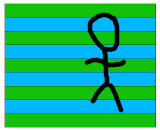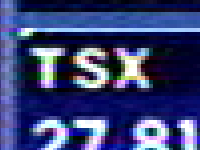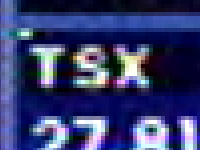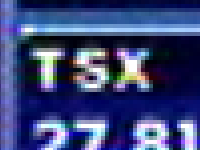Interlaced Video on a Computer Display
by Billy Biggs, 25 Nov 2003
This page attempts to visually explain some concepts of interlaced video and artifacts that occur upon display on a computer monitor.
1. Introduction
A sequence of frames viewed in succession can give the illusion of motion. A crappy hand drawn little dude can look (kinda) like he is walking, even though he is just a sequence of frames.

| |||

| 
| 
| 
|
When objects are in rapid motion, they also become more difficult to see clearly. For example, a car wheel appears as a solid blur when rotating fast enough.
Interlaced video is based on this concept. Rather than a sequence of frames like my animation above, video is a sequence of fields. A field is half of the horizontal lines that make up a full frame. Each field of video is half the size of a full frame, a huge savings in bandwidth!
Frame A | Frame B |

| 
|

| 
|
An interlaced signal sends just the green lines from frame A, and just the orange lines from frame B. While the individual fields alone are of poor quality, when viewed rapidly in sequence on a television, they give the illusion of a high quality stream.
2. Motion in Interlaced Video
The following is an example of motion in an interlaced video sequence. Here are two fields captured from an interlaced signal from a TV news channel.
Text in motion | |
 |
 |
Top field | Bottom field |
 |
 |
As the text moves, we can see that it actually changes shape on the television: the text is bouncing between large and small. However, since the text is in motion, our eye is not sensitive enough to notice this difference.
3. Still Images in Interlaced Video
Our eye is not sensitive enough when objects are in motion, what about if the scene is static?
Text standing still | ||
 |
 |
|
Top field | Bottom field | |
 |
 |
 |
This is an example of high detail in a video signal. The solid line above the stock market symbol TSX is only present in every top field. When viewed on a television, the line seems solid unless you stare at it closely. Why?
The interlaced stream is taking advantage of the human visual system's sensitivity to flashing stimuli. The idea is simple:
Flashing this evenly and fast enough:
 |
 |
 |
 |
Appears like this to a human observer:
 |
 |
 |
 |
4. Problems on a Computer Monitor
The above effect depends highly on the smoothness of the output pattern. A PAL signal sends 50 fields per second. What happens when we try to play this on a computer monitor at a refresh rate of 85 Hz?
Unfortunately, the 50 fps stream does not align evenly with the 85 Hz output. This can cause the visual effect to break down, appearing as stutters in the video. In tvtime, we include motion adaptive deinterlacers that attempt to detect static scenes, and avoid this problem by converting the interlaced signal into a set of frames that (hopefully) do not rely on the sensitivity of the human visual system to be viewed correctly. This is compensates for having an unsynced display.
An alternate scheme could involve a video card driver which allowed applications to set the refresh rate to match the video, and sync our output video to the display. This would require more powerful video card drivers than what we have today.
For more background on this problem, check out this great article by Dave Marsh. As well, I have some notes on this problem on my page about refresh rate sync problems, and in the deinterlacing FAQ.
For example, imagine a video signal that just flashes white and black (really hard on the eyes, but a good example!).

| 
| 
|
A flashing signal at 50 fps sampled on a computer monitor at 85 Hz | |
 |
 |
Gives this output | |

| |

| 
| 
|
5. Changelog
- 26 Nov 2003: Added example of the flashing signal.
- 25 Nov 2003: Initial post.